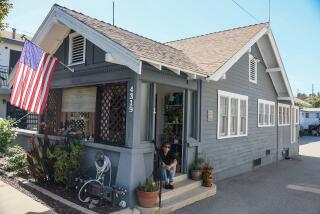Moratorium on Building Declared in Norwalk Area
- Share via
NORWALK — Fearing that water and sewer systems could eventually become overloaded, the City Council declared a 45-day building moratorium in an area near downtown where small apartment buildings are replacing aging, single-family homes.
The moratorium, which the council approved on a 4-0 vote Tuesday, covers residential areas north of Rosecrans Avenue along both sides of San Antonio Drive. Mayor Luigi A. Vernola abstained because he owns property in the district.
City planners said the moratorium will give them time to come up with a plan to deal with water and sewer demands. That could include more stringent limits on development, said Gregg Yamachika, acting director of community development. They also want developers to provide enough parking so streets do not become clogged with parked cars.
“We’re running into a lot of problems in these areas,” Councilman Mike Mendez said. “It’s a chance for us to stop and take a look.”
The City Council has scheduled a hearing June 5, when it could extend the moratorium for one year.
There was no opposition to the moratorium at Tuesday’s meeting, even though 12 planned apartment projects with 52 units will not move forward.
Yamachika said the conversion from single-family homes to small apartment buildings has been taking place over the last several decades. But he said the number of applications for such developments has increased in recent years.
Nineteen apartment projects have been approved by the city’s Design Review Board and Planning Commission in the last two years, he said. Of those, four projects with 14 units have been completed. The developers of three more projects containing 10 units have already received building permits and may proceed with construction.
But the developers of 12 projects, containing 52 units, will not be issued building permits during the moratorium. Several other apartment projects have been tentatively proposed by developers as well, Yamachika said.
“We’re seeing a lot of development in these areas of small apartment buildings,” he said. “They’re going to make an impact. We need to determine if all the problems are being addressed before we proceed.”
The moratorium area is zoned for apartments, and city officials are not trying to discourage construction, Yamachika said, but they are trying to avoid overloading water and sewer systems, as well as on-street parking.
Some developers have already had to install larger water mains to ensure adequate flow.
Yamachika said the city is trying to determine what type of overall water and sewer improvements will be needed and whether developers can bear the improvement costs.
Parking problems have resulted from the size of most of the residential lots in the moratorium area. Most are fairly small, 50 feet wide by 135 feet to 145 feet deep.
The Norwalk Municipal Code requires minimum lot sizes based on the number of apartment units. It also requires minimum open space, and on-site parking based on the number of apartment units.
The Design Review Board in the past has waived the guest parking requirement for some projects to enable developers to provide adequate open space in apartment buildings, Yamachika said. That means more cars parked on city streets.
The code requirements and need for waterline and sewer improvments can shrink a profit margin, discouraging developers from building in Norwalk. City officials are looking for a compromise.
“We have certain development standards that developers are having problems meeting,” Yamachika said. “At the same time, we have areas where we have waterline problems and sewers that don’t have capacity to handle greater density.”
Norwalk is the third Southeast city to pass a recent moratorium giving planners a chance to deal with commercial and residential development issues. Downey and Montebello passed their moratoriums last week.
More to Read
Sign up for Essential California
The most important California stories and recommendations in your inbox every morning.
You may occasionally receive promotional content from the Los Angeles Times.













